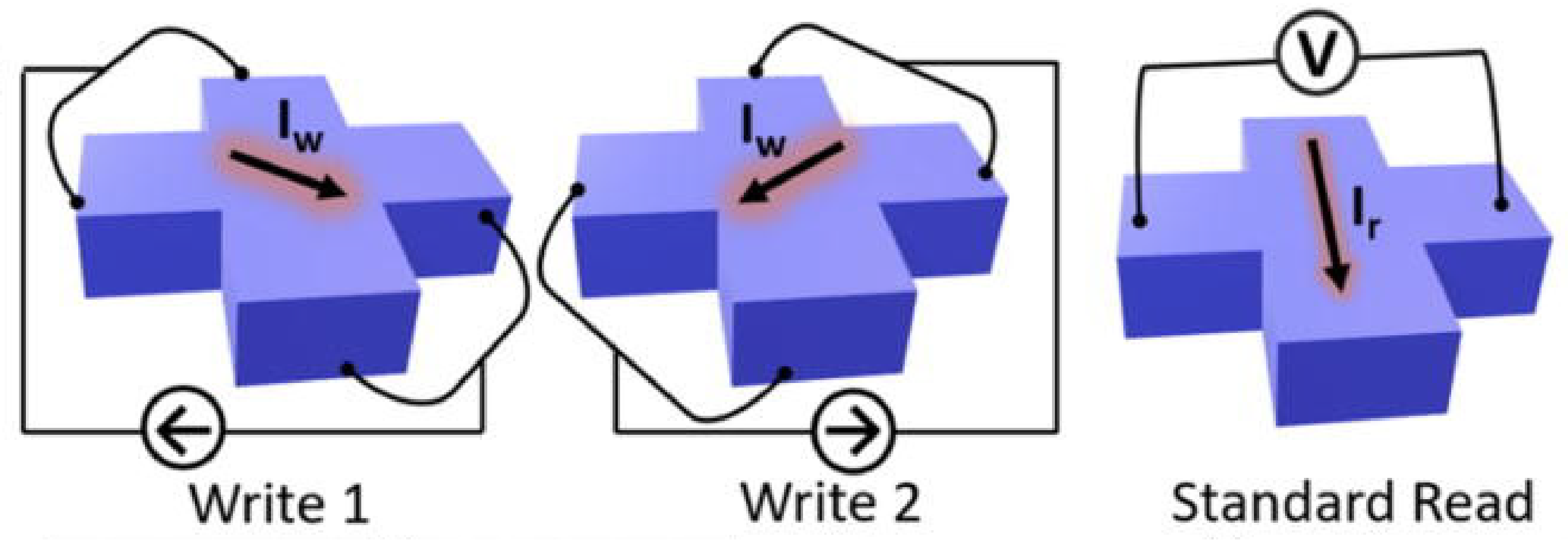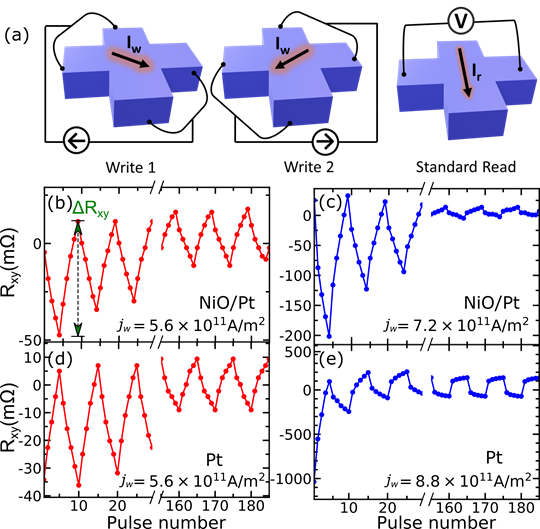
Antiferromagnetic Spintronics
Antiferromagnets are attractive candidates for future spintronic applications. Their antiparallel ordering of magnetic moments produces zero net magnetization, so they produce no stray fields and are insensitive to external magnetic field perturbations. Antiferromagnetic domain walls have been shown theoretically to approach relativistic speeds. The radiation hardness on a nanoscale combined with ultrafast spin-dynamics in the THz frequency range offers the prospect of novel non-volatile and rapid memory technologies. Meanwhile, long spin diffusion lengths and predicted superfluid transport of spin currents in antiferromagnetic insulating oxides in particular are attractive for low-power device operation.
Recently, there have been significant research efforts into the control and manipulation of spin-transport in antiferromagnetic heterostructures with both spin current and magnetic fields. The realization of electrical control of the Néel-order with spin-orbit coupling effects was a breakthrough in the field of spintronics. In this novel approach, a global electrical current generates a local staggered field which acts efficiently on the individual spin sublattices in non-centrosymmetric metals. In antiferromagnetic insulators, the Néel order can be switched by the antidamping spin-orbit torque generated by the spin accumulation from the spin Hall effect in an adjacent heavy metal layer. However, challenges remain in the detection and manipulation of the antiferromagnetic order, as thermal effects are significant in the electrical measurements commonly used for detection.

Electrical writing and reading of antiferromagnetic Neel vector in NiO(111)/Pt devices has been shown to be hindered by a large contribution from thermal effects arising in the heavy-metal Pt layer [see recent publication below].
We investigate the characteristics and origins of signatures in magnetoresistance measurements of spin-transport in insulating antiferromagnet/heavy-metal heterostructures. To obtain a full-picture understanding of antiferromagnetic spin-transport, we seek to use complementary approaches such as X-ray imaging techniques, manipulation via magnetic fields, and computational methods.
Researchers:
Liza
Recent Publications:
113. A. Wittmann, O. Gomonay, K. Litzius, A. Kaczmarek, A. E. Kossak, D. Wolf, A. Lubk, T. N. Johnson, E. A. Tremsina, A. Churikova, F. Büttner, S. Wintz, M.-A. Mawass, M. Weigand, F. Kronast, L. Scipioni, A. Shepard, T. Newhouse-Illige, J. A. Greer, G. Schütz, N. O. Birge, and G. S. D. Beach, “Role of substrate clamping on anisotropy and domain structure in the canted antiferromagnet α-Fe2O3” Phys. Rev. B, vol. 106, p. 224419 (2022). (view pdf)
112. E. A. Tremsina and G. S. D. Beach, “Atomistic simulations of distortion-limited high-speed dynamics of antiferromagnetic skyrmions,” Phys. Rev. B, vol. 106, p. L220402 (2022). (view pdf)
95. A. Churikova, D. Bono, B. Neltner, A. Wittmann, L. Scipioni, A. Shepard, T. Newhouse-Illige, J. Greer, and G. S. D. Beach, “Non-magnetic origin of spin Hall magnetoresistance-like signals in Pt films and epitaxial NiO/Pt bilayers,” Appl. Phys. Lett., vol. 116, p. 022410 (2020). (view pdf)